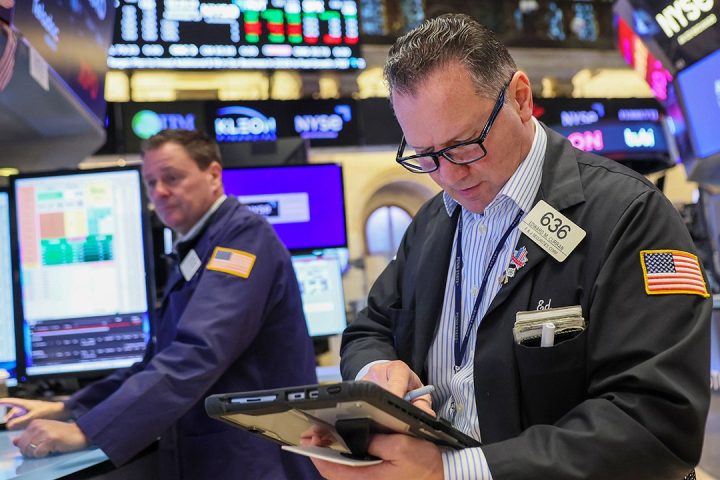Americans paid more than $105 billion in credit-card interest and another $25 billion in credit-card fees last year, according to the Consumer Financial Protection Bureau.
That’s a record-busting number surpassing the $87.6 billion in credit-card interest and $20.8 billion in fees that Americans paid in 2021, the federal regulator said Wednesday.
The numbers are a fresh reminder of credit-card debt’s growing weight for many Americans even as many keep spending. They reflect the toll of hot inflation and fast-rising interest rates in 2022.
But credit-card experts worry that last year’s record is just the start. Consumers will have paid even more credit-card interest and fees once regulators tally up the amounts for 2023, they estimate.
After all, annual percentage rates on credit cards have continued to climb this year following four rate hikes from the Federal Reserve. In 2022, the central bank increased its benchmark rate seven times, starting from nearly 0%.
More people are falling behind on their credit card-debts this year, shown by increasing delinquency rates. Credit-card debt surpassed $1 trillion during the second quarter, according to the Federal Reserve Bank of New York.
The share of credit-card debt that was at least 30 days behind climbed to 7.2%, marking the highest level since the first quarter of 2012, NY Fed data showed.
“I would expect all this to continue to build, but maybe the rate of change would be a bit slower,” said Ted Rossman, senior industry analyst at Bankrate.com. “We’re really seeing it on all fronts. Higher balances, higher rates, more people carrying more debt for longer periods of time.”
The average APR for new credit-card offers posted on Bankrate started at 16.3% in 2022 and finished at 19.6%, according to Rossman. That’s the largest one-year increase in Bankrate data stretching back to the 1980s, he noted. The average APR for a new card offer is now at a record high of 20.7%, he said.
There are even some store-issued credit cards that are now moving past the 30% APR mark, he noted.
The Fed’s own data shows that APRs are climbing for people carrying credit-card balances month to month. During the second quarter, that climbed to an average 22.16%, up from 16.6% the same time a year ago.
“With credit-card debt crossing the trillion dollar mark, we will be working to prevent bait-and-switch tactics when it comes to rewards and to increase refinancing activity so consumers can get lower rates,” CFPB Director Rohit Chopra said in a statement. The CFPB report also found that credit-card users are often charged more in interest and fees than they earn in rewards.
A banking industry trade organization pushed back on the report, noting that consumers aren’t the only ones contending with higher rates — it’s credit-card issuers too.
“With 11 interest rate increases in the last year and a half from the Fed, it’s not surprising that credit card rates have also risen,” said Sarah Grano, a spokeswoman for the American Bankers Association. “At the same time, every American knows that credit card companies are competing every day for their business, and consumers are able to shop for the card that best meets their needs.”
Credit cards have helped people steer through inflation and rate hikes, Grano said. But consumers should use competition in the industry to their advantage by shopping for the best rates. Cash-strapped consumers should also reach out to their card issuer because they could be eligible for assistance on their debts, Grano noted.
One expert cautioned that it can be “misleading” to focus on the $130 billion without a step back. “This is an eye-popping number, but it’s meaningless without context,” said Columbia Business School professor Brett House.
When CFPB researchers looked at the interest and fees as part of balances, they noted this “total cost of credit” was just under 18% of balance amounts for one type of credit card and more than 21% for another type of credit card.
House noted that interest rates and fees “simply returned to pre-pandemic levels after a dip during the COVID-induced shutdowns when balances came down at an unprecedented rate and interest rates were pushed down to emergency levels,” House said.
The Biden administration has been taking aim at ‘junk fees’
The CFPB report comes as the regulator and other Biden administration agencies have been focused on curbing unnecessary “junk fees.”
In 2022, credit-card issuers charged a record amount of annual fees, $6.4 billion, and a record amount of late fees, at $14.5 billion, the report showed. The data stretches back to 2015.
One proposed CFPB rule would push late-payment fees down to as low as $8, but would allow higher fees if necessary for collection costs. Last year, the average late fee was $32 for both first-time and repeat incidents, Wednesday’s report said.
The new report bolsters the case to curb credit-card late fees, said Chuck Bell, advocacy program director at Consumer Reports.
“As more Americans face difficult financial decisions between paying a credit card bill or paying for groceries, gas for their car, or housing, the CFPB’s proposed reforms would go a long way toward helping many people balance their household budgets,” Bell said in a statement.
But Grano said the agency should be cautious. “As this report demonstrates the growing use and popularity of credit cards in this country, the CFPB is proposing regulatory changes that could limit access to credit cards and the many benefits they provide. Those changes will harm consumers the most.”
Related: Are credit repair services worth it? For those struggling with debt, the answer is often no
Read the full article here






